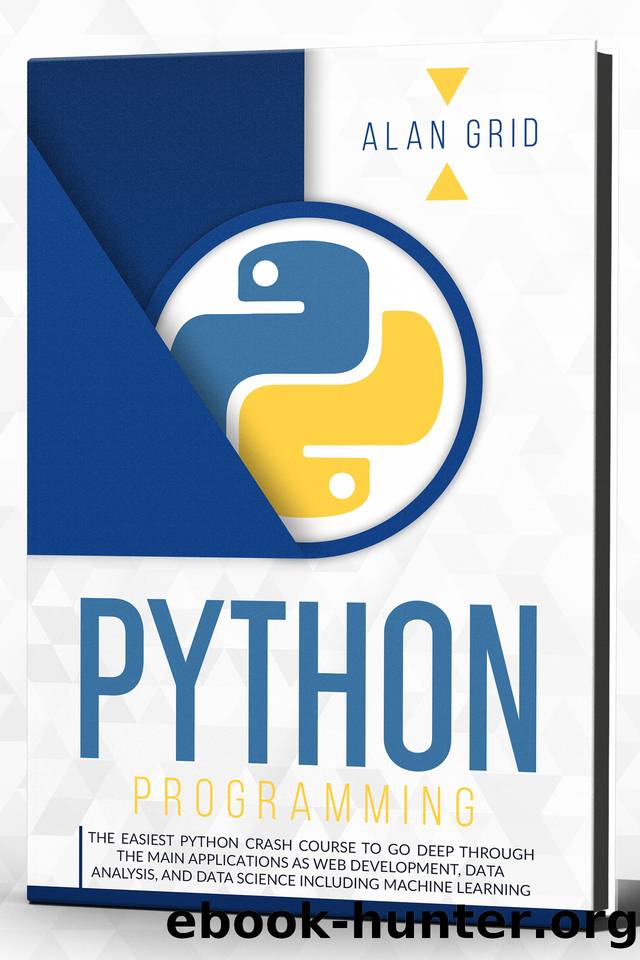Python programming : The Easiest Python Crash Course to Go Deep Through The Main Applications As Web Development, Data Analysis, And Data Science Including Machine Learning (computer science Book 1) by Alan Grid

Author:Alan Grid [Grid , Alan]
Language: eng
Format: azw3
Published: 2020-08-06T00:00:00+00:00
Chapter 6. Object-Oriented Programming and File Handling
Object-Oriented programming is an extensive concept used to create powerful applications. Data scientists are required to build applications to work on data, among other things. This chapter will explore the basics of object-oriented programming in Python.
Object-Oriented Programming abbreviated as OOP has several advantages over other design patterns. The development process is faster and cheaper, with great software maintainability. This, in turn, results in better software, which is also filled with new attributes and methods. The learning curve, is; however, complex. The idea might be complicated for newbies. In terms of computation, OOP is slower and consumes a lot of memory because more lines of code have been written.
Object-oriented programming relies on the important programming concept, which makes use of statements to change a program’s state. It concentrates on illustrating how a program should operate. Examples of imperative programming languages are Java, C++, C, Ruby, and Python. This is different from declarative programming, which deals with the type of computer program that should achieve, without detailing how. Examples consist of database query languages such as XQuery and SQL.
OOP relies on the property of classes and objects. A class can be considered as a ‘blueprint’ for objects. These can feature their own characteristics and methods they execute.
Example of OOP
Take an example of a class Dog. Don’t consider it as a specific dog or your own dog. We’re describing what a dog is and what it can do in general. Dogs have an age and a name. These are instance properties. Dogs can also bark; this is a method.
When you discuss a certain dog, you would have an object in programming: an object is a class instance. This is the basic state on which object-oriented programming depends.
Now let’s look at OOP in Python language.
Python is a powerful programming language that allows OOP. You will use Python language to define a class with properties and methods, which you will later call. Python has extra benefits than other languages. First, the language is dynamic and a high-level data type. This implies that development takes place faster than Java. It doesn’t need the programmer to declare variable types and arguments. This makes Python easy to learn for beginners. Its code is more intuitive and readable.
It is important to remember that a class basically provides the structure. This is a blueprint that outlines how something needs to be defined. However, it doesn’t offer any real content. For example, shape () class may specify the size and name of shapes, but it will not indicate the exact name of a shape.
You can view a class as a concept of how something should be executed.
Python Objects
Although the class is the blueprint, objects or instances are members of a given class. It’s not a concept anymore. It’s an actual shape, like a triangle with three sides.
Put differently; a class is like a questionnaire. It will define the required information. Once you complete the form, your actual copy is an instance of the class. It has original information relevant to you.
Download
This site does not store any files on its server. We only index and link to content provided by other sites. Please contact the content providers to delete copyright contents if any and email us, we'll remove relevant links or contents immediately.
| Ada | Ajax |
| Assembly Language Programming | Borland Delphi |
| C & C++ | C# |
| CSS | Compiler Design |
| Compilers | DHTML |
| Debugging | Delphi |
| Fortran | Java |
| Lisp | Perl |
| Prolog | Python |
| RPG | Ruby |
| Swift | Visual Basic |
| XHTML | XML |
| XSL |
The Mikado Method by Ola Ellnestam Daniel Brolund(20724)
Hello! Python by Anthony Briggs(20010)
Secrets of the JavaScript Ninja by John Resig Bear Bibeault(18332)
The Well-Grounded Java Developer by Benjamin J. Evans Martijn Verburg(17688)
OCA Java SE 8 Programmer I Certification Guide by Mala Gupta(17496)
Kotlin in Action by Dmitry Jemerov(17308)
Algorithms of the Intelligent Web by Haralambos Marmanis;Dmitry Babenko(16319)
Grails in Action by Glen Smith Peter Ledbrook(15467)
Sass and Compass in Action by Wynn Netherland Nathan Weizenbaum Chris Eppstein Brandon Mathis(13331)
Test-Driven iOS Development with Swift 4 by Dominik Hauser(10417)
Windows APT Warfare by Sheng-Hao Ma(7833)
Layered Design for Ruby on Rails Applications by Vladimir Dementyev(7549)
Blueprints Visual Scripting for Unreal Engine 5 - Third Edition by Marcos Romero & Brenden Sewell(7452)
Solidity Programming Essentials by Ritesh Modi(4568)
Functional Programming in JavaScript by Mantyla Dan(4445)
Hands-On Full-Stack Web Development with GraphQL and React by Sebastian Grebe(4433)
WordPress Plugin Development Cookbook by Yannick Lefebvre(4388)
Unity 3D Game Development by Anthony Davis & Travis Baptiste & Russell Craig & Ryan Stunkel(4270)
The Ultimate iOS Interview Playbook by Avi Tsadok(4252)
